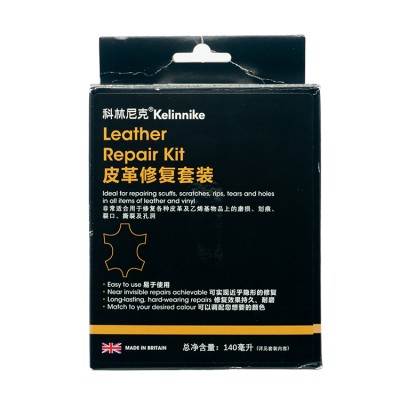
To the left is a leather seat from an MR2, as can be seen, with years of use it has suffered significant damage to the left hand side
The friction caused by rubbing against the leather has, over the years, resulted in a hole being made and a lot of abrasion to the surface.
PRODUCTS REQUIRED
- Complete Leather Repair Kit - To Repair the hole
- Small Leather Colourant Kit - Used to restore the leather colour.
We also have a full selection of Leather Car Seat Repair products on our website.
METHOD
STEP 1. PREPARE THE LEATHER CAR SEAT

The first step it to prepare the leather for repair. Using the Leather Prep & abrasive pad, included in the Colourant Kit, gently rub the surface of the leather to remove any grease and oils that have accumulated.
This step will also remove any loose fibres and remove the manufactured finish allowing the colourant, applied later in this tutorial, to adhere to the leather properly.
After prepping, wipe the leather down with the Alcohol Cleaner, this will remove any dirt or dust from the area before moving on to the next step.
STEP 2. TIDY THE AREA

If you look at the hole you can see that the leather is sticking outwards, like a lip. This lip will compromise the quality of the repair and it should be removed.
Using the scalpel or a pair of scissors, carefully remove the lip by cutting it away at the base, taking care not to damage the surrounding leather.
STEP 3. APPLY THE BACKING PATCH

In order to provide a firm backing for the repair, the canvas sub-patch should be applied. Take the patch supplied in the kit and cut it to size, it should be enough to completely cover the repair with an additional 1cm of material surrounding the hole.
Once this is done use the tweezers to insert one side of the patch underneath the leather so that the 1cm excess is completely under the leather. Apply pressure to hold this in place and gently feed the patch under the remaining edges of the hole. When done the patch should lie flat under the repair, and the 1cm surrounding material we left should be underneath the leather on all sides.
When this is done, put a small amount of Leather Glue onto the spatula supplied and feed this underneath the edges of the hole to coat the underside of the leather surrounding it, taking care not to move the canvas patch. When all edges have been glued, apply pressure to bond the leather to the patch and allow to dry.
STEP 4. FILL THE HOLE

Now that the backing patch is firmly in place, the hole in the leather must be filled. In order to do this; take a small amount of the Heavy Filler using the end of the palette knife and place a thin layer into the hole over the backing patch. Make sure all the layer is very thin, just covering the sub-patch and allow 20 minutes to dry, this can be speeded up by using a hair dryer.
Keep applying the heavy filler in thin layers, it is crucial to use thin layers as the filler shrinks as it dries and may not cure properly if the layers applied are too thick. As a general rule, at least 5-6 thin layers should be used to build up the filler until the filler level is built up to just below the top of the hole.
To remove excess, with the application of each layer, smooth the area over with the sharper edge of the palette knife before drying the layer applied.
STEP 5. MORE LAYERS OF FILLER

This is an illustration of what the hole will look like after 5 or 6 layers of filler have been used.
It will not be smooth but it will have nearly filled the hole completely.
STEP 6. ADD THE FINAL LAYER OF FILLER

Apply the final layer of filler to the hole, completely filling it so that it is on an even level with the surrounding leather on the seat. Take care to let this final layer cure properly as when cured the filler can shrink, reducing it to below the desired level.
Add more repair filler if necessary.
If you rub over the hole and filler gets onto the leather, remove it with the palette knife.
Your aim is to fill the hole so that it is level with the leather and not over filled. If you do over fill it, you can reduce it with sandpaper.
When you are happy with the level of the filler, and you can no longer feel any 'ridge' between the level of the filler and the surrounding leather, clean the area with the Alcohol cleaner again to remove any unwanted filler and dust from the surrounding area.
STEP 7. APPLY AN INITIAL COAT OF COLOURANT

The colourant supplied with the kit should have been matched to the colour of the leather item being repaired, unless you are completely re-colouring it.
Take one of the sponges supplied in the kit and apply a small amount of colourant to it, then rub this into the area of the repair thoroughly. This allows the colourant to penetrate into the creases of the leather and valleys of the grain, giving a better overall finish.
When this is done, move onto the next step, where the colourant is sprayed on.
STEP 8. FINISH THE JOB

Using an airbrush spray as many thin coats of colour over the leather car seat to thoroughly blend in the repair. For the best result, ensure that each coat is very thin and is given sufficient time to cure before applying the next. This will enable an even finish to be built up and will avoid problems with uncured colourant. It is not uncommon for the best repairs to apply 10-15 thin coats of colourant, depending on the extent of the damage and the colour used.
Once you are happy that the repair is concealed, the colourant is cured properly and it is well blended with the surrounding leather, the finish can be applied. Using the spray gun apply 4 or 5 thin coats of the finish, again allowing time for it to dry between each coat. The finish seals the colourant in the leather preventing it from wearing and prolongs the leathers life.
When complete, allow 24 hours before using the item, to ensure the filler, colourant and finish have cured sufficiently.
In addition to the Leather Repair Kit, the Small Leather Colourant Kit was used to colour this job as the area being repaired was quite large and required spraying.









